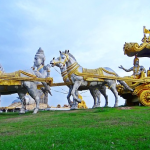Response to the Doctrine of Sameness
The World Negating Thesis
A notion has become widespread that non-duality is escapism from the mundane world. This has become the handle with which Vedanta got dismissed on the basis that:
- It does not bring about advancement in the human condition because it advocates that the human condition as we experience is a false construction, hence there is no need to try and improve it;
- It causes complicity with poverty, social abuse and is therefore socially irresponsibile;
- Hence, such a people are naturally dependent upon the “progressive” West for help.
Many colonial era writers developed this thesis using Hindu source materials as interpreted by the colonialists, and many Hindus ended up supplying them the fodder. Sometimes I call this notion as pop Vedanta; it is also called Neo-Vedanta. This thesis has become robust and well established in many segments of the academy, public policy, media and popular culture, both Western and Indian. I shall refer to this misinterpretation of dharma as the world-negating thesis.
Ken Wilber’s manipulative claims
Ken Wilber uses this thesis to claim that he has superseded whatever dharma offers. This is done in a series of logical steps as follows:
- He reduces Hindu dharma into what he calls “Advaita Hinduism”, thereby ignoring all other schools.
- He misinterprets “Advaita Hinduism” to make it fit the above description of world negation.
- He praises this “Advaita Hinduism” in ways that make many naive persons satisfied that he has given it the credit due.
- He collapses Sri Aurobindo’s teachings into this worldview or a similar one – even though Sri Aurobindo vehemently criticized all such interpretations of Vedic thought.
- He then appropriates copiously from various dharmic schools – Sri Aurobindo, Madhyamika Buddhism, Kashmir Shaivism, to name a few – in order to claim that he has moved past the problems that dharma suffers from. I refer to this as intellectual arson – the arsonist is one who first robs the place and then burns it down to hide the evidence.
- He then claims to have achieved states of consciousness that supersede Sri Aurobindo and all others before him, including Buddha.
- He calls this his trademarked Integral Theory, and has started merging it into what he calls Integral Christianity, Integral Judaism, etc. (Ironically, there is no Integral Hinduism movement in his organization, presumably because intellectual arson operates by deleting the source. If he were to equally foster Integral Hinduism, as I have proposed to his people, it would demonstrate that there is virtually nothing new or original in his Integral Theory.)
Hardly any Vedanta teacher I come across is aware of such games and traps which they keep falling into. When all this is pointed out to them, they tend to be dismissive and indulge in what I call the posture of loftiness. This posture consists of claims like: we are all one; all paths lead to the same place; all religions are the same; etc. Many of them have, indeed, joined Wilber’s bandwagon either directly, or indirectly via third party intermediaries.
Falsifying the World Negating Thesis
As BEING DIFFERENT elaborates, Ramanuja and subsequently Sri Jiva Goswami were very clear and explicit that non-dualism does not mean that multiplicity is false. It means that multiplicity is dependent upon Oneness, and in the case of Sri Jiva all multiplicity is a form of the One, just as a smile is a form of the face and cannot exist independent of it. If the face is real then its smile and all other forms are real as well, even though they exist only in dependence on the face. The blueness of the blue lotus cannot exist separately from the lotus – another common example given in the tradition. This is the nature of the relationship between One and Many. Another metaphor to understand the multiplicity is as lila, divine play. Multiplicity is not false, be it seen as form of Brahman (Saguna Brahman) or as lila.
I have asked Swami Dayananda Saraswati, arguably the most prominent authority on Vedanta philosophy in the public square today: If the world is unreal then what is the reason for performing our dharma and karma, for concern over what evangelists do, for wanting to cure diseases and helping those in need, for raising our kids well, etc? I have had this discussion many times. He gives very clear explanations to the effect that: we must deal with the differences in the world we live in as part of dharma, karma, etc.
The Gita’s message is also this. Arjuna gave the escapist argument at first, to justify his inaction, and it takes Sri Krishna 18 chapters to explain why action in the world is necessary – without attachment to the results and without even the sense of being the doer.
The problem is that the Sanskrit word “mithya” has been mistranslated as false, when it is closer to “relative” or “contingent” existence. Even though your tasks today in the office are not permanent , you must still perform them as best as you can today. They are transitory and relative, but not false. Similarly, maya has been translated incorrectly that the world is illusory, when the correct meaning is that our mental construction of the world is illusory until such time as we attain enlightenment.
Are Oneness and Difference mutually contradictory?
The above misinterpretation of the nature of multiplicity has led many dharma scholars to criticize my notion of difference. They think that emphasizing difference is a bad idea because it takes us away from unity. Shouldn’t we be discussing only Oneness, they ask?
My response is that asserting differences is not a negation of Oneness. It is the right insight into the richness of Oneness that Oneness includes all differences as aspects within itself.
Therefore, the dharma/Christian difference is as real for our lives as the dharma/adharma or deva/asura or the tamas/sattva differences.
One’s experience of difference depends upon where one stands in terms of state of consciousness. If you are the rishi rooted in unity consciousness as your state (not mere shlokas one can parrot), then by all means you should act in the world in spontaneity – the One leads your actions amidst all the diversity. But if you are not there yet, you must make a conscious effort to understand right from wrong, what is what in the world – while at the same time reminding yourself that this relative level of multiplicity is a manifestation of the unity.
A related argument often given is the slogan “vasudhaiva kutumbakam” which means “the world is one family”. This is used to claim that therefore there are no differences. But members of a family differ. The kauravas and pandavs in Mahabharata are one family and yet at war. The devas and asuras are one family and yet in mutual tension. Not only humans but all life including animals, plants, bacteria, etc. comprise the “vasudhaiva”; yet we apply viveka (discrimination) to differentiate and do not treat them interchangeably.
Moron Smriti
Since the 1990s, I have been compiling such moronic statements and critiques into a book that I hope to publish one day. It is to titled, Moron Smriti. It discussed what morons frequently say and my responses, as well the history of how this syndrome emerged some centuries back and ended up in the mainstream of Indian society.
According to the logic of morons, medicine could be substituted with poison because both are Brahman only; prasad can be replaced with excreta because they are only mithya, you need not obey any laws because these are man-made in the world of illusions, and so forth. In other words, the misunderstanding I refer to is very dangerous because when taken to its logical conclusion it results in a large population of morons who are simply dysfunctional.
Morons are the product of slavery under Islamic rule and subsequent glorification of the moron mindset under colonialism. It is easy to rule over morons by convincing them that their own glorious heritage encourages them to adopt the world negating thesis, and to therefore let others take control over this-worldly affairs.
Further reading
Myth of Hindu Sameness: http://rajivmalhotra.sulekha.com/blog/post/2004/11/myth-of-hindu-sameness.htm
BEING DIFFERENT, by Rajiv Malhotra, Harpercollins, Delhi, 2011. www.BeingDifferentBook.com














